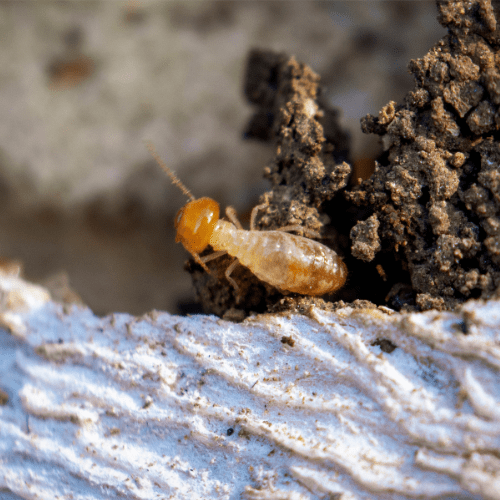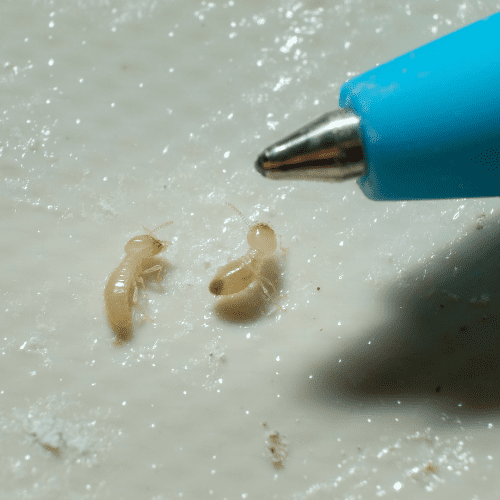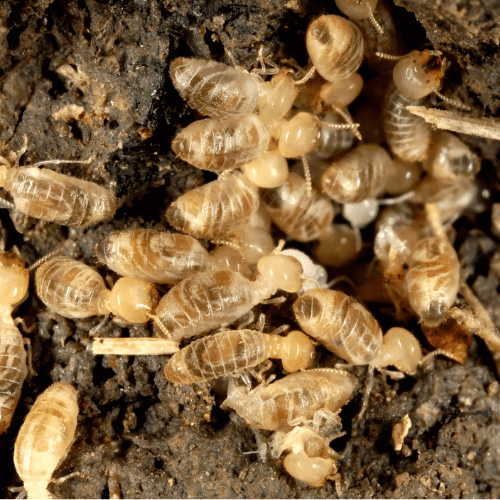


Termites can cause serious damage to a home, often without being detected until it’s too late. These small insects can eat away at the wooden structures of a house, leading to costly repairs and potential safety hazards. However, there are steps homeowners can take to prevent termite infestations and keep their homes termite-free.
One of the first things homeowners can do to prevent termite infestations is to eliminate any moisture sources in and around the home. Termites are attracted to damp environments, so fixing leaky pipes, ensuring proper drainage, and using dehumidifiers can all help reduce the likelihood of an infestation. Additionally, homeowners should avoid storing firewood or other wooden materials near the home, as these can serve as a food source for termites.
Another key step in preventing termite infestations is to regularly inspect the home for signs of activity. This can include looking for mud tubes along the foundation, checking for hollow-sounding wood, and keeping an eye out for swarming termites. By catching an infestation early, homeowners can take action to eliminate it before significant damage occurs.
Understanding Termites and Their Behavior
Termites are small, pale insects that feed on wood and other cellulose-based materials. They are known to cause extensive damage to homes and structures, making it important to understand their behavior and how to prevent them from infesting your home.
Types of Termites
There are three main types of termites: subterranean, drywood, and dampwood. Subterranean termites live in underground colonies and are the most common type found in the United States. Drywood termites, on the other hand, live in dry wood and are typically found in warmer climates. Dampwood termites live in damp wood and are most commonly found in the Pacific Northwest.
Signs of Termite Infestation
It is important to be able to identify the signs of a termite infestation. Some common signs include discarded wings, mud tubes, and frass (termite droppings). Discarded wings are a sign that termites have swarmed and are looking for a new place to establish a colony. Mud tubes are small tunnels made of soil, wood, and termite saliva that termites use to travel between their colony and food source. Frass is the termite’s excrement and is often found near their feeding sites.
Termite Life Cycle
Termites have a complex life cycle that includes several stages. The first stage is the egg stage, followed by the larval stage, nymph stage, and finally the adult stage. After mating, the queen will lay eggs that hatch into larvae. The larvae will then molt and develop into nymphs before finally becoming adults. The length of the termite life cycle varies depending on the species and environmental conditions.
In order to prevent a termite infestation, it is important to understand their behavior and take proactive measures to protect your home. This includes regular inspections, maintaining proper ventilation and moisture control, and treating any infestations promptly. By taking these steps, homeowners can help ensure that their homes remain termite-free.
Preventive Measures for Your Home
Termites can cause significant damage to your home, but there are steps you can take to prevent an infestation. By reducing moisture accumulation, properly storing wood and cellulose materials, and conducting regular inspections and maintenance, you can keep your home termite-free.
Reducing Moisture Accumulation
Moisture attracts termites, so it’s essential to reduce any accumulation of moisture in and around your home. Regularly inspect your home for leaks and address any issues promptly. Make sure your gutters are clean and functioning correctly, and ensure proper ventilation in your home. Proper ventilation can help reduce humidity levels, which can also attract termites. Additionally, ensure that your foundation is properly graded to prevent water from accumulating around your home.
Proper Storage of Wood and Cellulose Materials
Termites are attracted to wood and cellulose materials, so it’s crucial to store them properly. Keep firewood and other wood materials away from your home’s foundation, and store them off the ground. Avoid using mulch near your home’s foundation, and keep cardboard and other cellulose materials away from your home.
Regular Inspection and Maintenance
Regular inspections and maintenance can help you catch termite activity early and prevent significant damage to your home. Inspect your home’s crawlspace and vents annually, and seal any gaps or cracks in your home’s foundation. Conduct regular inspections of your home’s interior and exterior, paying close attention to areas where wood and cellulose materials are present.
By following these preventive measures, you can reduce your home’s risk of a termite infestation and protect your investment.
Termite-Proofing Structural Components
Termites are notorious for their ability to infiltrate and damage structural components of homes. However, there are ways to termite-proof your home’s structural components and avoid costly repairs. Here are some effective measures to keep your home termite-free.
Fortifying the Foundation and Entry Points
Termites can enter your home through small openings, cracks, and holes in the foundation. Therefore, it is essential to inspect your home’s foundation regularly and seal any gaps or cracks with a suitable sealant. You can also install physical barriers, such as stainless steel mesh, around pipes and other entry points to prevent termites from entering your home.
Protecting Wood Surfaces and Furniture
Termites feed on wood, so it is crucial to protect your home’s wood surfaces and furniture. You can use termite-resistant wood or apply a protective coating to wood surfaces. Additionally, it is essential to keep your furniture away from walls and off the ground, as termites can easily climb up walls and enter furniture from the bottom.
Landscaping and Yard Maintenance
Termites thrive in moist environments, so it is crucial to maintain your yard and landscaping properly. Keep your yard free of wood piles, tree stumps, and other debris that can attract termites. Additionally, ensure that your gutters and downspouts are functioning correctly and directing water away from your home’s foundation.
By following these termite-proofing measures, you can protect your home’s structural components and avoid costly repairs. Regular inspections and maintenance can go a long way in preventing termite infestations.
Professional Termite Control Options
When to Call a Professional
In some cases, a termite infestation can be so severe that it requires professional attention. If you notice signs of termites such as mud tubes, damaged wood, or discarded wings, it may be time to call a professional exterminator. Additionally, if you have tried DIY methods without success, it is best to seek the help of a professional pest control service.
Termite Treatment Methods
Professional termite control options include liquid treatments, bait stations, and termite baits. Liquid treatments involve applying a liquid insecticide around the perimeter of the home, while bait stations and termite baits use a slow-acting poison that is carried back to the colony by the termites themselves.
It is important to note that professional termite control is a specialized service that requires the expertise of a trained exterminator. A professional service will assess the extent of the infestation and determine the best course of action for your specific situation. They will also provide ongoing monitoring and maintenance to ensure that the termites do not return.
Overall, professional termite control options can be an effective way to eliminate a termite infestation. By knowing when to call a professional and understanding the different treatment methods available, homeowners can take proactive measures to keep their homes termite-free.
DIY Termite Prevention and Treatment
Termite infestations can be costly and damaging to your home. Fortunately, there are several DIY solutions to prevent and treat termite activity. Here are some natural and chemical repellents, home remedies, and monitoring techniques to help keep your home termite-free.
Natural and Chemical Repellents
Natural and chemical repellents can be used to deter termites from entering your home. Some common natural repellents include beneficial nematodes, which are microscopic worms that feed on termites, and essential oils such as neem oil, which can be sprayed around the perimeter of your home.
Chemical repellents such as fipronil can also be effective in preventing termite activity. These chemicals can be applied to the soil around your home or used in bait stations to kill termites.
Home Remedies for Termite Management
Boric acid is a popular home remedy for termite management. It can be mixed with water and applied to wood or other surfaces to deter termites. However, it is important to note that boric acid can be toxic to humans and pets if ingested.
Another home remedy is orange oil, which is extracted from orange peels. It can be applied to wood or other surfaces to kill termites. However, it may not be as effective as other treatment options.
Monitoring and Responding to Termite Activity
Regularly monitoring your home for termite activity can help prevent infestations. Look for signs such as mud tubes, discarded wings, and wood damage. If you suspect termite activity, it is important to respond quickly to prevent further damage.
One effective way to monitor termite activity is to use bait stations. These stations contain wood or other materials that are attractive to termites. Once termites are detected, they can be treated with chemicals or beneficial nematodes.
By using natural and chemical repellents, home remedies, and monitoring techniques, you can help keep your home termite-free.
Aftermath of Termite Infestation
Assessing and Repairing Damage
Once a termite infestation has been detected and treated, it is important to assess the damage caused by the insects. Termites can cause significant structural damage to a home, including weakening wooden beams and causing walls and ceilings to sag. Property damage can also occur, as termites can eat through furniture, flooring, and even clothing.
To assess the damage, homeowners may need to hire a professional inspector to evaluate the extent of the infestation. Once the damage has been assessed, repairs can begin. This may involve replacing or reinforcing damaged wooden beams, repairing drywall, and replacing damaged flooring or furniture.
Long-Term Strategies to Prevent Recurrence
To prevent future termite infestations, homeowners can take several long-term strategies. One of the most effective ways to prevent termites is to use termite-resistant wood in construction. This type of wood is treated with chemicals that make it less attractive to termites. Homeowners can also use physical barriers, such as metal mesh, to keep termites from entering the home.
Regular inspections by a pest control professional can also help prevent future infestations. These inspections can identify potential entry points for termites and other pests, allowing homeowners to take preventative measures before an infestation occurs.
Overall, it is important for homeowners to take termite prevention seriously to avoid the costly and damaging aftermath of an infestation. By taking proactive measures and addressing any infestations quickly, homeowners can protect their property and ensure the safety of their home.
Frequently Asked Questions
What natural methods are effective in deterring termites?
There are several natural methods that can help deter termites from infesting a home. These include using cedarwood, neem oil, and orange oil. Cedarwood contains natural oils that are toxic to termites, while neem oil and orange oil have compounds that repel termites. Additionally, planting certain plants such as mint, garlic, and marigold around the foundation of a home can also help deter termites.
What are the best practices for termite-proofing a home?
The best practices for termite-proofing a home include removing any wood debris or dead trees from the property, keeping firewood and lumber away from the home, and sealing any cracks or crevices in the foundation or walls. Homeowners should also ensure proper ventilation in crawl spaces and attics to prevent moisture buildup that can attract termites.
Which substances can be applied to wood to prevent termite infestation?
Several substances can be applied to wood to prevent termite infestation, including borate, copper, and zinc. These substances are toxic to termites and can be applied to the wood during construction or as a treatment after infestation. Homeowners should consult with a professional pest control company to determine the best treatment for their specific situation.
How can homeowners prevent termite swarms from entering their property?
Homeowners can prevent termite swarms from entering their property by sealing any cracks or crevices in the foundation or walls, using screens on windows and doors, and keeping outdoor lights off at night. Additionally, removing any dead trees or wood debris from the property can help deter termites from swarming.
Are there permanent solutions for eradicating termites?
While there are several treatments available for eradicating termites, there is no permanent solution. Regular inspections and preventative measures are necessary to ensure a termite-free home.
What are the most effective preventative treatments for termites?
The most effective preventative treatments for termites include regular inspections by a professional pest control company, treating the soil around the foundation of the home with termiticides, and using bait stations to monitor termite activity. Homeowners should also ensure proper ventilation in crawl spaces and attics to prevent moisture buildup that can attract termites.

